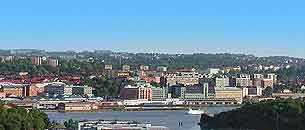Gothenburg University (Goteborgs Universitet)
University Information, Campus and History
(Gothenburg, Sweden)
Gothenburg University is one of the leading universities in Sweden and a major research and development centre in Europe. It has over 51,000 students and 5,500 employees, making it the largest university in Scandinavia. It is also an international university, cooperating with countries within and outside the European Union in over 2,000 collaborative projects.
Established in 1891 with the help of private donations, Gothenburg University was originally known as Gothenburg University College. It employed seven professors, teaching seven subjects to 21 students. Over the years, it absorbed other previously independent units and gained independent university college status in 1907. Its merger with the Gothenburg School of Medicine paved the way for its attaining university status in 1954.
Today, Gothenburg University has eight faculties and around 60 departments, offering some 150 regular courses and 1,300 specialised courses every year. It offers one of the most diverse programme lineups in Sweden, making it a popular choice among Swedish school leavers and foreign students. Its academic units and facilities occupy a large part of the Gothenburg coast, giving it the feel of a small community and making it an integral part of the city's culture.
Facilities
The Gothenburg University library is the largest in Sweden, comprising seven libraries focusing on specific subject areas. It has an impressive collection of books, reference materials, and periodicals, and a fast-growing database of electronic information. It has over 14,000 electronic magazines, 20,000 electronic books, and 300 databases, and the collection continues to grow as more academic journals become available in electronic format. The library also has specially adapted facilities for the visually impaired, including enlargement programmes, speech synthesis, and Braille printers and displays.
Gothenburg also has a university television station, which is used for training in media and TV production. University announcements, shows, and news reports are broadcast from here by media and production students. It also cooperates with the Swedish Knowledge Channel, an educational media programme.
Classes are held in the university's spacious, well-equipped classrooms. There are also outdoor venues for class discussions and debates, as well as botanical gardens designed for both study and leisure.
Famous Students
Gothenburg University was home for a number of people who have made their mark in different fields, from science and medicine to philosophy and the arts. Perhaps the most prominent Gothenburg alumnus is Arvid Carlsson, who won the Nobel Prize for Medicine in 2000 for his work on dopamine and Parkinson's disease.
Ernst Cassirer, known for his theories on symbolic forms, was a professor at Gothenburg University from 1935 to 1941. Renowned historian Erik Lonnroth has a PhD in history from the university, which he earned at the young age of 24. Lonnroth pioneered the study of medieval economic history in Sweden and psychohistory, a field exploring the psychological motivations behind historical events.
The Swedish Minister of Foreign Affairs, Jan Eliasson, has a master's degree in economics from the university's School of Economics and Commercial Law. Percy Barnevik, former CEO of Swedish electric company ASEA, also went to the same school. He was known for initiating the merger between ASEA and its competitor Brown Boveri.
Other famous Gothenburg alumni are Sture Allen, professor of computational linguistics at the university and secretary of the Swedish Academy from 1986 to 1999, and Bernhard Karlgren, famous for his scholarly studies on Chinese culture and Asian languages.
The Gothenburg University website provides adequate information for prospective local and foreign students, including downloadable forms and online enquiry forms. For more information on the admission and application process, you can call their Student Information Office at +(46)(031) 773-1050 or send a fax to +(46)(031) 16-28-71. The office welcomes prospective students and will answer questions on application timetables, fees, and examinations. You can also request application forms from this number, or download them from the university website.
Foreign students can study at Gothenburg via a student exchange programme, provided that they come from one of its partner universities abroad. Independent students can apply for admission as well. For questions on foreign student admission, call the Exchange Student Services office at +(46) (31) 773-1086/5337 or send a fax to +(46)(31) 773-5126. Application forms can be downloaded at the Exchange Student Services section of the university website, or requested via phone.
| Contact
Gothenburg University (Goteborgs Universitet): |
Address: Karl Gustavsgatan 29, B0, SE 405 30, Gothenburg (Goteborg), Sweden
|
Tel: +46 (0)31 786 10 00
Fax: +46 (0)31 786 43 87
Email: admissions@gu.se
Website:
http://www.gu.se |
 |
